Introduction
As one reviews and evaluates the vast literature on diffusion of innovations [3, 4, 6, 7, 14], he gets a distinct impression that most researchers in the area have a pro-change bias. This is indicated by the following research emphasis:
- Learning and understanding the psychology of innovators and early adopters rather than that of the followers.
- Profiling the early adopters with respect to demographic, life style and communication characteristics to identify and differentiate them.
- Developing communication and other strategies with which to accelerate the process of adoption and diffusion.
- Utilization of early adopters as change agents in a two-step flow of communication and influence.
- Labeling the change resistors as laggards with a clear derogatory perspective toward them.
According to Rogers [5]
The second important bias found in most diffusion research is an inherent pro—change bias, which assumes chat the innovations are “good” and should be adopted by everyone. Undoubtedly hybrid corn was profitable for each of the Iowa farmers in the Ryan and Gross (1913) study, but most other innovations that have been studied do not have this high degree of relative advantage. Many individuals, for their own good, should not adopt them (p. 229).
In fact, the vast majority of people who have no a priori desire to change may be more typical and even more rational than a small minority of individuals who seek change for its ownsake rather than, or in addition to, the intrinsic value of the innovation. Therefore, it is about time we paid respect to individuals who resist change, understand their psychology of resistance and utilize this knowledge in the development and promotion of innovations rather than thrust upon them preconceived innovations which may or may not have any value to the masses. There are several compelling reasons for this conclusion.
First, the research evidence suggests that the true innovators (the first two to three percent adopters) are more likely to be social deviants, abnormal in their epistemic drive, and adopt innovations in— discriminately rather than based on any rational choice calculus. Why should we understand them and motivate others to emulate their behavior?
Second, we have developed and promoted many technological innovations without properly understanding or even examining their side effects or longer term effects on human life. This seems to be particularly true in the twentieth century era which has pushed the society from a mechanical—electrical age to a chemical—electronic age of mankind with the immediate prospect of migrating into the nuclear age.
Third, many critics in Europe and Asia argue chat the pro—change attitudes of scientists and marketers generates planned obsolescence which, in turn, encourages waste and overutilization of natural scarce resources.
Fourth, most marketing innovations fail in the market place. This entails a tremendous amount of waste of scientific and marketing resource s. Perhaps the knowledge about why people resist change may motivate scientists and marketers to become more realistic in channeling their expertise and efforts and thus become more productive.
Fifth, the pro—change bias leads to increased inequity according to Roling[8]. In fact, some even charge that the rapid development and promotion of innovations are the root cause for the increasing gap between the “haves” and the “have nots” of the world, which in turn, results in greater tensions and conflicts among nations and people.
Finally, it is argued that the quality of life has deteriorated rather than improved in the technologically driven mass consumption societies. Products chat break down frequently, increased number of consumer complaints and consumer dissatisfaction as well as the emergence of consumerism are cited as examples of lessening the quality of life.
Perhaps it is none of these reasons but simply a consequence of the aging process which is motivating me to theorize about the psychology of innovation resistance.
Habit and Risk Constructs
It seems easier to theorize about individuals who resist innovations rather than those who embrace them. The two psychological constructs which seem most useful in understanding the psychology of Innovation resistance are: (a) Habit toward an existing practice or behavior, and (b) Perceived risks associated with innovation adoption.
1. Habit toward Existing Practice.
The strength of habit associated with an existing practice or behavior is hypothesized to be the sing le most powerful determinant in generating resistance to change. Without this motivational incentive, an individual is not likely to voluntarily pay attention to innovation communication or to voluntarily commit himself to try it out. In fact, his perceptual and cognitive mechanisms are all likely to be tuned in to preserve the habit because the typical human tendency is to strive for consistency and status quo rather than to continuously search for, and embrace new behaviors. In other words, formation and sustenance of habits is much more prevalent than innovativeness among people.
One exception to the above proposition is when the motivation underlying the formation and continuity of an existing behavior or practice is weakened by satiation or replaced by other motivations due to aspiration or adaptation processes. However, these changes in motivational structure are more evolutionary and do not match in velocity the rapidity with which innovations are developed and marketed, while variety seeking (Russell and Mehribian, [9]), curiosity behavior (Berlyne [1]) and psychology of complication (Howard and Sheth, [2]) do occur in reality, they still represent only a small percentage of total human behavior except perhaps in :hose individuals with an abnormal dominance of the epistemic trait.
Habit toward an existing practice includes all the behavioral steps involved in the process of selecting, acquiring and using an existing alternative. In consumer behavior, it includes all the behavioral acts associated with shopping (time and place choices), procuring (money and effort choices), and consuming (storage, packaging and serving choices) the product. In other words, habit includes the total behavioral stream as a system rather than the terminal act.
The following propositions emerge with respect to habit and innovation resistance relationship:
- The stronger the habit toward an existing practice or behavior, the greater the resistance to change and the innovations associated with that change. While this is a monotonic relationship, it is not likely to be linear. The hypothesis is that it is a curvilinear relations hip with a logistic function possessing both a lower asymptote and an upper asymptote.
- Those innovations which generate change for the total behavioral stream will be resisted core strongly than other innovations which generate change for a single behavioral act in the stream of selection, acquisition, and usage.
- While habit is a major determinant for generating resistance to change, : is not the sole determinant. Thus, even in the absence of strong habits, resistance to change may be present due to other factors. One such other factor is perceived risks associated with the innovation.
2. Perceived Risks Associated with Innovations.
A second major deter— determinant of innovation resistance is the perception of different risks associated with the adoption of an innovation. There are three major types of risks: (i) aversive physical, social or economic consequences; (ii) performance uncertainty; and (iii) perceived side effects associated with the innovation.
The following propositions are suggested for the risk—resistance relationship:
- The higher the perceived risk, the greater the innovation resistance. While the risk—resistance relationship is monotonic, it is not likely to be linear. The hypothesis is that the curvilinear relationship is a logistic function with both lower and upper asymptotic properties.
- Innovations which are discontinuous (Robertson, [3]) are likely to be resisted more than continuous innovations since they entail all the three types of risks.
- Perceived risk is a major determinant of innovation resistance but it is not a sole determinant. Thus, even in the absence of any risk, people will resist change due to habits toward an existing practice.
A Typology of Innovation Resistance
3ased on the habit—risk constructs, it is possible to create a typology of innovations in terms of the degree and nature of resistance they might encounter if developed and marketed. Table 1 summarizes the four types of innovations. Each is described below.
These are innovations which face the strongest resistance from people due to both strong prior habits and high risk perceptions about the innovation. Many innovations in the area of planned social change or social programs fall in this category. Examples include education, welfare, population control, nutrition and conservation (Sheth and Wright, [13]).
Dual resistance innovations have the highest prospects of failure. It is, therefore, not surprising to observe the high failure rate in social programs and the consequent frustrations experienced by the social policy makers and their change agents.
Dual resistance innovations must work backward by first focusing on the psychology of innovation resistance and then developing specific innovative programs which will minimize risk perceptions, on the one hand, arid work through the existing habits rather than attempt to replace them. The classical examples in this area come from the failures of high protein — low cost foods. In less developed countries, Sheth and Sudman [12] recommend that social policy makers will be better off offering nutrition in beverages rather than ±n solid foods since habits are much more strongly embedded for solid foods, and performance uncertainty and social risks are far greater with new types of processed foods in many cultures.
2. Habit Resistance Innovations.
Innovations which are low risk but require changes in existing habits and practices are classified as habit resistance innovations. Many of the continuous innovations which attempt to replace existing products fall in this category. As Rogers (1977) points out, most of these replacement innovations offer very little relative advantage to motivate the farmers to change. I think, a vast majority of-product innovations in marketing are of this kind: They offer very little above and beyond the existing products and consumers perceive them as “me too” products or artificial differences, and consequently reject them. This is presumably the classic reason for the failure of freeze—dried coffee: Housewives perceived it as no better than existing instant or regular coffees on the market place despite the enormous technical differences in the manufacturing process.
Only those replacement innovations succeed which improve rather than change the existing habits and practices by offering cost or performance or social advantages. Examples include electronic calculators, light beer for heavy beer drinkers or low tar and nicotine cigarettes.
3. Risk Resistance Innovations.
Certain types of innovations face resistance primarily because of high risk perceptions although they do not replace existing habits but instead generate altogether new habits. These are the most radical and discontinuous innovations. According to Howard and Sheth [2], there is no prior product class for these innovations and the innovation itself defines a new product class. Many technological breakthroughs such as nuclear energy, birth control pills and picture phone are examples of risk resistance innovations. They generate new habits but, at the same time, also raise risk perceptions in terms of both main effects and side effects.
It should be pointed out chat those technological breakthroughs which are perceived to be low risk face minimal or no resistance at all. Examples include the adoption of the telephone, the television and the computer.
4. No Resistance Innovations.
Those innovations which neither contain any risks nor attempt to change existing habits are labeled as no resistance innovations. The most coon examples of no resistance innovations are the fads and fashions. Similarly, innovations which offer high relative advantage and low risk (Shech, [11]) should face no resistance.
Unlike other types of innovations, the no resistance innovations are likely to have exponential growth functions as opposed to the more common logistic growth functions associated with their diffusion. Fads and fashions clearly suggest this to be true.
Hopefully, the above typology of innovations resistance will be helpful to policy makers and change agents in realizing what types of innovations may be most difficult to diffuse, and therefore, knowing situations in which it may be desirable to work backwards from understanding the psychology of resistance.
Modeling Innovation Resistance
It seems possible to mathematically model innovation resistance. Figure 1 suggests how habit and risk factors are related to innovation resistance.
The following equation represents the model:
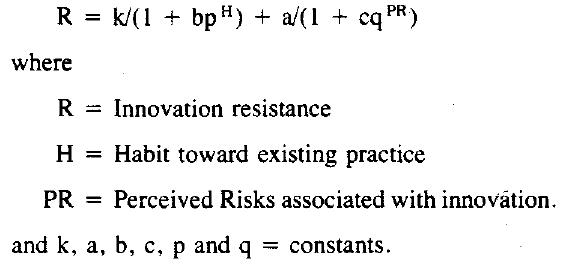
There are two problems associated with the above equation. First, habit and perceived risk are multiattribute phenomena. As we discussed earlier, habit represents conditioning toward the total behavioral stream associated with selection, acquisition and utilization processes. Similarly, perceived risk consists of aversive consequences, performance uncertainty, and side effects. One way to reduce the multiattribute profiles of habit and perceived risk is to transform them into indices. Rat her than averaging or summing, it is proposed that a principal components analysis be performed on each profile and extract a general component or factor as representing the index of habit and perceived risk respectively.
Second, it is difficult to simultaneously estimate parameters with two logistic functions in the above equation. There are three separate procedures one can utilize for parameter estimation.
1. Aggregate Curve Fitting.
In this option, we should combine the habit and perceived risk factor scores for each observation and thereby reduce the problem to a bivariate curvilinear curve fitting. In other words, innovation resistance is optimally related to the aggregate sum score of habit and perceived risk, and the parameters estimated are for the aggregate function.
The equation will look as follows:
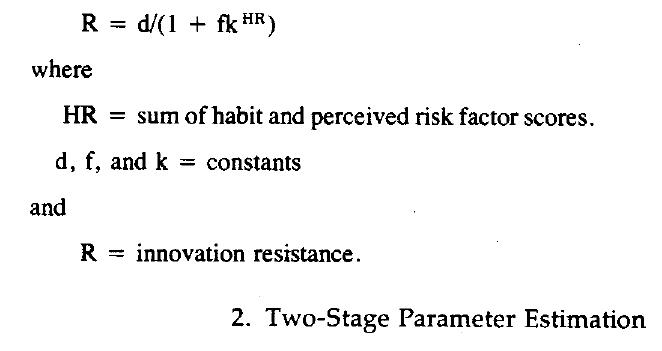
2. Two stage parameter Estimation.
This procedure entails estimating parameters with respect to one determinant of innovation resistance, calculating the residuals, and then estimating parameters for the second determinant by curve fitting of the residual scores. Since habit is hypothesized as the stronger determinant, it is possible to suggest the following two—stage procedure:
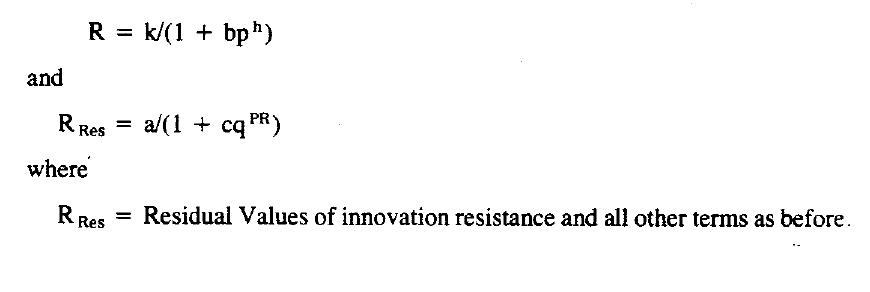
3. Linear Approximation Analysis
The third and the simplest option is to approximate the logistic relationships of each factor by a linear approximation. : is obvious that the linear approximation will underestimate innovation resistance when habit and risk are weak and overestimate it when they are strong. In other words, the parameters will generate biased estimations in the extreme values of observations by presuming a linear relationship. If the asymptotic constants in the logistic function are not very large, the linear approximation will produce a good f it.
The following equation represents the linear approximation for the model:
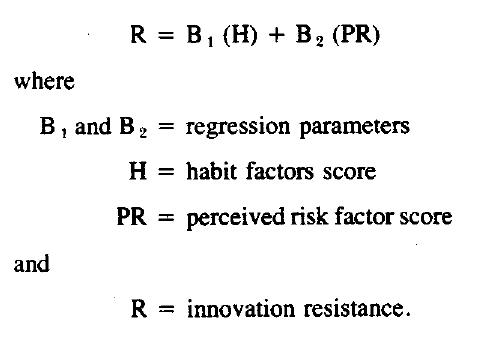
Among the three approaches, the two—stage process and linear approximation may be more relevant and useful, if the policy makers are interested in estimating the relative contributions of habit and perceived risk in generating resistance to a particular innovation. On the other hand, if the interest is in forecasting the overall resistance toward a particular innovation, the aggregate curve fitting may be quite adequate.
Conclusions
This paper attempts to theorize about why people resist innovations. Since the vast majority of people either have no a priori desire to change or actually resist change, it is argued that we might learn more by concentrating on the psychology of innovation resistance rather than on the psychology of adoption. Indeed, the literature of diffusion and adoption seems to be so pro—change in its bias, that psychology of innovation resistance has, so far, remained a less developed concept.
Two factors which determine innovation resistance are habit coward an existing practice and perceived risks associated with the innovation. Both are hypothesized to have a logistic function relationship with innovation resistance. Several statistical methods are suggested for estimating the parameters of the two logistic curves including aggregate parameter estimation, two—stage curve fitting and linear approximation procedures.
Finally, the paper provides a typology of innovation resistance. Dual resistance innovations are those which are high risk and attempt to change existing practice. Risk resistance innovations are those high risk technological breakthroughs which create new habits. Habit resistance innovations are those which attempt to replace existing practices; and finally no resistance innovations are those which are either highly advantageous — low risk technological innovations or fads and fashions which encounter no resistance either due to habit or due to perceived risks.
References
1. Berlyne, D. E. (1966), “Curiosity and Exploration,” Science, Vol. 153, No. 3731, pp. 25—33.
2. Howard, J. A. and J. N. Sheth (1969), The Theory of Buyer Behavior, Wiley.
3. Robertson, T. S. (1971), Innovative Behavior and Communication, Molt, Rinehart and Winston.
4. Rogers, E. M. (1962), Diffusion of Innovations, Free Press.
5. Rogers, E. M. (1977) “New Product Adoption and Diffusion,” in R. Ferber (ed.) Selected Aspects of Consumer Behavior, NSF, U.S. Printing Office, pp. 223—238.
6. Rogers, E. M. and F. F. Shoemaker (1971), Communication about Innovations, Free Press.
7. Rogers, E. M. and P. C. Thomas (1975), Bibliography on the Diffusion of Innovation, Department of Population Planning, University of Michigan.
S. Rolling, N.; J. Ascroft and F. Chege (1974) “Innovation and Equity in Rural Development,” paper presented at the World Congress on Sociology, Toronto, 1974.
9. Russell, J. A. and A. Mehrabian (1976), “Environmental Variables in Consumer Research,” .Journal of Consumer Research, Vol. 3, pp. 62—63.
10. Ryan, B. and N. C. Gross (1943), The Diffusion of Hybrid Seed Corn in Two Iowa Communities,” Rural Sociology, Vol. 8, pp. 15—24.
11. Sheth, .J. N. (1971) “Word of Mouth Communication in Low—Risk Innovations,” Journal of Advertising Research, Vol. 11, pp. 15—18.
12. Sheth, J. N. and S. Sudman, “Malnutrition and Marketing,” in Sheth and Wright (eds.) Marketing Analysis for Societal Problems, Bureau of Economic and Business Research, University of Illinois.
13. Sheth, J. N. and P. 1… Wright (eds.) (1974), Marketing Analysis for Societal Problems, Bureau of Economic and Business Research, University of Illinois.
14. Zaltman, Gerald (1974), “Strategies for Diffusing Innovations,” in Sheth and Wright (eds.) Marketing Analysis for Societal Problems, Bureau of Economic and Business Research, University of Illinois.


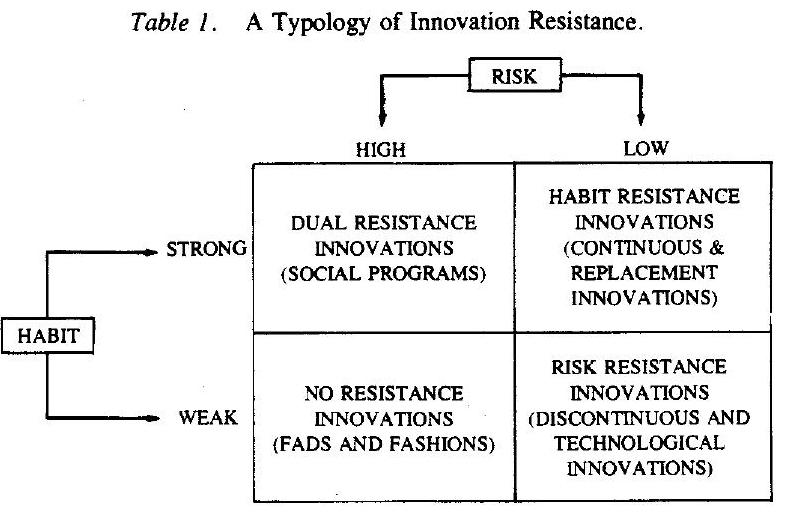


Is the graph within the research mistaken, since no resistance should be weak on both risk and habbits